WW1 Monuments & Memorials on the Western Front Battlefields
There are many and varied monuments and memorials to the people who were involved in the military units fighting on the Western Front battlefields and to many civilians who were caught up in the war and who lost their lives. As a result of the utter destruction from the weaponry, the large scale of the major engagements and the type of siege warfare endured for much of the four years on the Western Front the loss in human and animal lives was very high. Also, the remains of many thousands of casualties who died on all sides within the fighting zones were unrecognizable, destroyed or lost. There are, therefore, numerous monuments to be found on the Western Front which are there to commemorate the names of those killed and missing with no known grave.
This page is an introduction to the British & Commonwealth, Belgian, French and German memorials to be seen there. There is a link also on this page to our listings in the various battlefield sectors showing the major monuments of interest to visitors with photographs and map locations.
- British & Commonwealth Monuments & Memorials
- Belgian Monuments & Memorials
- French Monuments & Memorials
- German Monuments & Memorials
- Demarcation Stones/Bornes du Front
- Listings and Locations for Monuments arranged by Battlefield Sectors on the Western Front
British & Commonwealth Monuments & Memorials
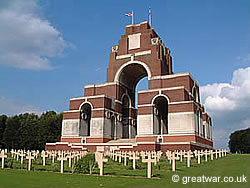
|
On The Western Front numerous official national memorials were erected on the battlefields to commemorate the large numbers of lives lost by the Allies.
Ex-Service organizations contributed by private subscription to memorials remembering a military unit such as a division, regiment or battalion.
Some individuals were also remembered by families or groups who could afford to raise enough money to place a stone as a memorial to a particular person.
Immediately after the war some of the relics of the fighting and memorials on the battlefields were deliberately left in situ as a memorial to the events that had taken place there. In most cases it was the nations on the side of the Allied victory which were in a easier position to demonstrate publicly their desire for remembrance by leaving their memorials on the battlefields. Some of these original such memorials have been stolen, damaged or or removed since 1918. Some have been replaced in recent times with a replica or modern version of that memorial.
Belgian Monuments & Memorials
Military Monuments
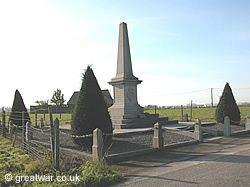
|
In early October 1914 the Belgian Army made a fighting withdrawal from the city of Antwerp. The King of Belgium and his forces took up a position holding the sector of the Yser at the far northern end of the Western Front between the sand dunes on the Belgian coast and the town of Ypres (Ieper). Belgian monuments to military units are to be found in this battle sector.
Memorials to Civilians
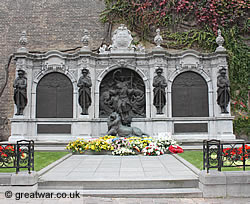
|
The local population of many hamlets, villages and towns found themselves embroiled in the war along the fighting zone of the Western Front from the Belgian coast at Nieuwpoort to the Belgian-French border at Armentières. Civilian casualties were caused by the fighting and there are memorials to commemorate the names of those who died.
Local War Memorials to Military Dead
Many villages and towns in Belgium have a memorial to the local men who fought in the military and who did not return to their homes.
Demarcatiepalen: Demarcation Stones
Demarcatiepalen is the Belgian name for the series of stone monuments set up along the old Western Front to mark the line of the furthest advance into Belgium and France by the German Army between 1914 and 1918. For a further description see the heading Bornes du Front: Demarcation Stones in the section below on French Monuments.
French Monuments & Memorials
Military Monuments

|
The French Army suffered many thousands of casualties even within the first few weeks of the war in the late summer and autumn of 1914 during the Battles of the Frontiers. Large-scale battles between the French and German Armies in Artois, Aisne, Champagne and Verdun between 1915 and 1917 resulted in large numbers of casualties for both sides. There are numerous monuments to military units and individuals on the battlefields where the French Armies were in action on the Western Front.
The Lantern Tower in the battlefield area of Artois is a national French memorial to the fallen of the First World War. A far-reaching, revolving beacon of light shines deep into the landscape every night. The tower is situated on the top of a high ridge and in the centre of the largest national French military cemetery in the world at Ablain St. Nazaire (also known as Notre Dame de Lorette).
Local War Memorials
Visitors to France will see that most towns and villages have a war memorial commemorating men from the community who served in the Great War and who did not return home.
In many cases civilian casualties are also commemorated, sometimes on the same memorial. Villages and towns which found themselves in the 1914-1918 war zone suffered casualties from artillery bombardments or street fighting before the civilians were formally evacuated. Many towns and villages along the length of the Western Front were occupied by Allied and/or German military forces either in the fighting zone or in the rear areas.
Those villages which found themselves in German occupied territory at some stage during the war did also suffer civilian losses from reprisal shootings. Where the German Army was attacked by co-ordinated terrorist tactics known as “franc-tireur” in the early weeks of its invasion of France executions did occur according to local sources. Some civilians were shot if they were believed to have been caught spying on the occupuying Germans.
German Monuments & Memorials
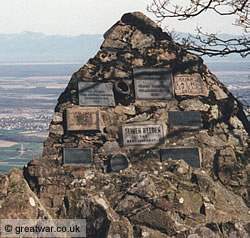
|
By the time of the Armistice on 11th November 1918 the defeated German Armies on The Western Front had withdrawn from regions of France and Belgium which they had occupied under German military rule for up to four years. They had abandoned their memorials dedicated to their own fallen comrades and battles they had won.
As the defeated enemy they could only hope that the Allies would respect any German military memorials for the loss in human life that they represented. It would take until the mid 1920s before the Germans were able to establish formal relations with France and Belgium to allow preservation work to be carried out on German military cemeteries and surviving German memorials.
After the war there was major development work carried out on the German military burial sites, with all of the smaller burial locations being brought together into large collecting cemeteries. In some cases post-war memorials were incorporated into these large cemeteries.
Bornes du Front: Demarcation Stones

|
A memorial to the First World War was proposed by the French sculptor Paul Moreau-Vauthier, himself a Veteran and survivor of the Battle of Verdun. His idea was to create a a line of small monuments to be located along the line on the Western Front which was the furthest point to which the German Army had penetrated into France. It was also the same line of departure from where the Allied Armies launched what was to be the victorious offensive known as the Advance to Victory against the German Army in the summer and autumn of 1918.
Demarcation Stone Monuments on the Western Front
Listings & Locations of Battlefield Monuments & Memorials
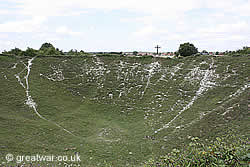
|
Our listings of memorials and monuments on the Western Front battlefields are arranged by battlefield region. Each listing provides a numbered list with a map location for the more well-known and accessible memorials on the battlefields. These include monuments to military units, individuals, local civilian casualties, sites of national commemoration, and battlefield remains preserved as memorials.
Monuments & Memorials on the Antwerp, Yser/IJzer Battlefields & Belgian Coast
Ypres Salient Monuments & Memorials
French Flanders & Artois Monuments & Memorials
Related Topics
Battles of the Western Front
For an overview and map of the battles which took place on the Western Front from early August 1914 to mid November 1918 see our page at:
Records for the War Dead of WW1
See our information page about how to find the records of people who died in military service in the First World War. The page includes contacts for the various international war grave agencies and other suggested sources of information:

